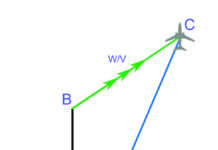I clearly remember my first experience breaking out on final after an instrument approach. It was late Thanksgiving, on the second leg of a seven-hour cross-country. At the time, I was an IFR noob with very little experience flying “in the system,” much less in actual IMC. I had been flying above a cloud layer, but with an hour remaining in my flight and the sun setting, the deck had finally sealed off my view of the ground. Fortunately, temperatures were warm, the layer was only a few thousand feet thick and the bases were reported at 1800 feet agl. It seemed like the perfect opportunity to experience breaking out without being anywhere near IFR minimums.
As I crossed the final approach fix, I dropped beneath the veil of clouds and emerged from a sharply delineated cloud base. The view was just like the magazine photos, with approach lights, a sequenced flasher (the rabbit), plus runway and VASI lights directly in front of me. Everything looked exactly as it was supposed to be. I was even on the glideslope. Whew! I had successfully broken out, and had enough of the runway environment to continue the approach and land.
Unrevealing
In retrospect, my first experience was almost too good, because none of the other for-real IFR approaches have matched it. It’s not just that the runway often doesn’t pop out. Since then, subsequent approaches have involved coming in and out of clouds randomly, emerging from the sides of clouds, and, worst of all, remaining in foggy bases all the way to the ground.
I’ve come to realize that “breaking out” is a misnomer. It isn’t always a well-delineated point like it was for me that first time. The runway environment often vaguely emerges like a ghost ship out of the fog. When it emerges more and more clearly, the better equipped you are to make good decisions, but the more tentative the reveal, the more likely pilots are to make errant decisions based on incomplete visual data and wishful thinking.
In other words, breaking out isn’t the sequence when an aircraft emerges from the cloud bases. Instead, it’s the decision space where the pilot flips modes from instrument to visual, and begins the process of lining up for the runway.
Transitioning from instrument to visual references can be awkward. That hint of ground sliding by beneath and the possibility of a runway ahead can divide a pilot’s attention, which makes you neither a good VFR nor a good IFR pilot, but stuck in the transition between the two. It is the point where accidents happen, when signs are not sufficiently clear and the clock on a go/no-go decision runs out with inadequate or incorrectly interpreted visual cues: Is that a runway or a road? Are those runway lights? Is that a tower? Why is that warehouse in front of me? Oh wait, there’s the runway over there.
Losing It
A common mode of failure after breaking out near minimums is landing long, which often results in damage after running out of runway. A second mode of failure is missing the runway entirely. Unlike landing long, the accident sequence usually begins on contact with something other than a landing surface. Since these also occur at higher speeds, the crash physics can be more energetic, resulting in greater damage and risk of injury.
Last year, around Thanksgiving, a pilot coming into the Hilton Head (S.C.) Airport (KHXD) did not have a clean breakout. After being cleared to land his Socata Trinidad TB-20 in night IMC, the pilot switched to CTAF and repeatedly tried activate the runway lighting. As he descended, he observed the approach path indicator lights, but could not see the runway edge lights. Again he attempted to activate the runway lights, which did not respond. The subsequent landing was “high and long,” and ended off the runway resulting in substantial damage to the plane’s right wing. The pilot later reported he may have incorrectly tuned the CTAF.
A Beech Baron pilot executed an ILS approach with a tailwind because the weather was below minimums for the wind-favored runway. The pilot began the process of a go-around 100 feet above the ILS decision height, but did not increase engine power. He then observed the runway centerline markings and decided to touch down. The airplane floated and landed long with only 1000 feet remaining on a 7001-foot-long runway, at a speed of 85 knots with a tailwind. The airplane traveled off the end of the runway, coming to rest upright in a grass area.
In these cases, the pilots identified a runway upon breaking out, but there wasn’t enough of it remaining to have a happy ending. Put another way, the airplane arguably had been in a position from which a “descent to a landing on the intended runway can be made at a normal rate of descent using normal maneuvers,” as the regulation requires. (See the sidebar on page 14 for more on the relevant FAR.)
But the airplane didn’t stay in that position, and a go-around wasn’t initiated when the maneuver’s outcome became in doubt. In both of these accidents, injuries were minimal.
Don’t Touch Nuthin‘
If you don’t land long, what might be a related failure mode? You guessed it: Landing short. With the proliferation of GPS-based approaches to seemingly every runway, circling to land hasn’t gone away, but it’s easier than ever to fly an accurate approach to a specific runway. That means a lot of straight-in procedures, many of them with glidepath guidance all the way to the touchdown zone.
In many accidents where the airplane lands short, the pilot spies the runway environment straight ahead and begins to descend toward it. The only problem is he likely already is descending toward it, on the electronic glidepath, or at least one from which a normal descent can be made.
A natural response to sighting the runway environment is to configure the airplane for landing. But—again—it already is, or at least should be. The landing gear should be down, regardless, and whether to use an approach flap setting depends. The trick is we often either reduce power and/or add flaps, either of which bends downward the airplane’s trajectory short of the touchdown zone. Without some combination of restoring power, reducing drag or pitching up—and consequently slowing down—we’ll come up short of the runway every time.
It’s often much better to leave well enough alone upon breaking out on final. If you’re doing it right, you should be in a stable descent toward the runway, calculated to put you between 500 and 1500 feet from the threshold.
It doesn’t always work out that way, of course, and maneuvering of some kind—mainly low-altitude turns, hopefully of the coordinated kind—will be needed to align with the runway. That’s when Aerodynamics 101 gets involved, to further complicate things.
Depending on the bank angle, of course, banking reduces the wings’ production of vertical lift, in favor of the horizontal kind. What happens when generated lift is reduced and all else remains equal? The airplane descends, perhaps to come up short of the runway, unless the pilot adds adequate nose-up input on the pitch control.
To help prevent this type of accident, consider limiting bank angle to half-standard rate when maneuvering after breaking out at minimums. Use rudder to coordinate the turn, and pay attention to your descent rate. If you can’t maneuver the airplane to a position over the runway threshold from which you can land on the runway remaining without banking beyond standard-rate, considering going around.
Off-Course
According to FAR 91.175(c), we can descend to 100 feet above the touch down zone elevation (TDZE) on a precision or non-precision approach as long we always are in a position to land, have the required visibilities for the approach and can see the entire approach lighting installation, including the red lights. (Some of the FAR’s additional details are highlighted in the sidebar on the opposite page.) The hint of runway lights through the haze and fog, however, might not be sufficient to pull off a successful landing. Pilots who break out without a runway fare much more poorly than those who have a clear shot.
The worst-case scenarios involve breaking out with no runway environment in sight at all, or with just enough view of one to be tempted into circling to land. This often happens when pilots stray from the approach course or misread the approach procedure. Breaking out low and away from the final approach course is wrought with perils, chief among them are obstructions and terrain. Unfortunately, the reports of these events are harder to interpret because the examples that make us suspect that the pilot may have broken out without a landable runway often have a fatal result.
Go Missed
Sometimes the breaking out relief you are hoping for never comes. When that happens, there is only one option: Go missed. At or near the decision height/minimum descent altitude without the runway environment in sight only leads to trouble. Seeing a glimpse of a tree, a road or a cow is not “the runway environment” you need to positively identify so you can land safely.
For newly minted instrument pilots, the decision point comes when you are at maximum task saturation. This is the time when you are trying to hold the needles steady, you are keeping your scan up to remain on the numbers, and, as you look down and ahead for signs of terra firma, you are likely drifting off course, requiring corrections. And all the while, you must also be counting down the altimeter, either for the published decision height or your personal minimum. This is when you are at maximum task saturation. When that time comes, do not hesitate.
Even if you are starting to see hints of the ground beginning to appear, your life depends on swift execution of the go around and missed approach. If you can see the ground, you may be able to see the runway after a second approach.
The closer you are to the published minimums when breaking out, the less likely you are to break out cleanly and the more likely you are to simply transition from IFR flying in a cloud, to VFR flying on the fringes of a cloud frighteningly close to the ground. You’ll be doing this while looking for visual cues good enough to confirm a runway environment granting you permission to continue.
Hold What You’ve Got
Breaking out isn’t about weather conditions as much as it is about decision-making. When you break out, you should be in VFR conditions or you should keep flying the plane by instruments. Don’t be suckered into thinking that sight of the ground is good enough. Ground that is not an airport is an illusory song of Siren.
Once you’re convinced you have the runway environment in sight, stop what you’re doing and let the airplane continue its descent toward the runway. Chances are good you’ll end up on the aiming point if you just hold what you’ve got.



